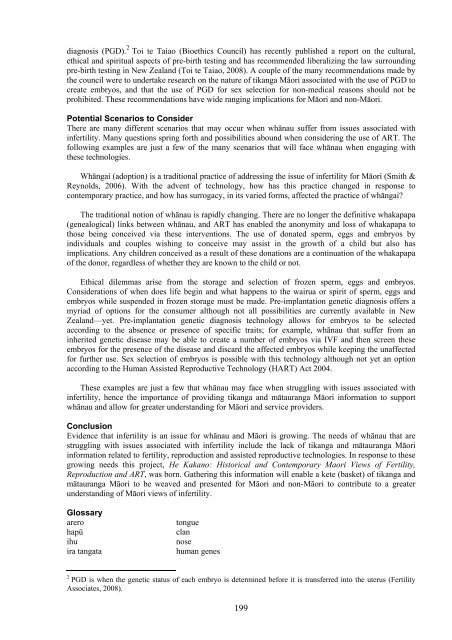traditional knowledge conference 2008 te tatau pounamu
traditional knowledge conference 2008 te tatau pounamu
traditional knowledge conference 2008 te tatau pounamu
You also want an ePaper? Increase the reach of your titles
YUMPU automatically turns print PDFs into web optimized ePapers that Google loves.
diagnosis (PGD). 2 Toi <strong>te</strong> Taiao (Bioethics Council) has recently published a report on the cultural,ethical and spiritual aspects of pre-birth <strong>te</strong>sting and has recommended liberalizing the law surroundingpre-birth <strong>te</strong>sting in New Zealand (Toi <strong>te</strong> Taiao, <strong>2008</strong>). A couple of the many recommendations made bythe council were to undertake research on the nature of tikanga Māori associa<strong>te</strong>d with the use of PGD tocrea<strong>te</strong> embryos, and that the use of PGD for sex selection for non-medical reasons should not beprohibi<strong>te</strong>d. These recommendations have wide ranging implications for Māori and non-Māori.Po<strong>te</strong>ntial Scenarios to ConsiderThere are many different scenarios that may occur when whānau suffer from issues associa<strong>te</strong>d withinfertility. Many questions spring forth and possibilities abound when considering the use of ART. Thefollowing examples are just a few of the many scenarios that will face whānau when engaging withthese <strong>te</strong>chnologies.Whāngai (adoption) is a <strong>traditional</strong> practice of addressing the issue of infertility for Māori (Smith &Reynolds, 2006). With the advent of <strong>te</strong>chnology, how has this practice changed in response tocon<strong>te</strong>mporary practice, and how has surrogacy, in its varied forms, affec<strong>te</strong>d the practice of whāngai?The <strong>traditional</strong> notion of whānau is rapidly changing. There are no longer the definitive whakapapa(genealogical) links between whānau, and ART has enabled the anonymity and loss of whakapapa tothose being conceived via these in<strong>te</strong>rventions. The use of dona<strong>te</strong>d sperm, eggs and embryos byindividuals and couples wishing to conceive may assist in the growth of a child but also hasimplications. Any children conceived as a result of these donations are a continuation of the whakapapaof the donor, regardless of whether they are known to the child or not.Ethical dilemmas arise from the storage and selection of frozen sperm, eggs and embryos.Considerations of when does life begin and what happens to the wairua or spirit of sperm, eggs andembryos while suspended in frozen storage must be made. Pre-implantation genetic diagnosis offers amyriad of options for the consumer although not all possibilities are currently available in NewZealand—yet. Pre-implantation genetic diagnosis <strong>te</strong>chnology allows for embryos to be selec<strong>te</strong>daccording to the absence or presence of specific traits; for example, whānau that suffer from aninheri<strong>te</strong>d genetic disease may be able to crea<strong>te</strong> a number of embryos via IVF and then screen theseembryos for the presence of the disease and discard the affec<strong>te</strong>d embryos while keeping the unaffec<strong>te</strong>dfor further use. Sex selection of embryos is possible with this <strong>te</strong>chnology although not yet an optionaccording to the Human Assis<strong>te</strong>d Reproductive Technology (HART) Act 2004.These examples are just a few that whānau may face when struggling with issues associa<strong>te</strong>d withinfertility, hence the importance of providing tikanga and mātauranga Māori information to supportwhānau and allow for grea<strong>te</strong>r understanding for Māori and service providers.ConclusionEvidence that infertility is an issue for whānau and Māori is growing. The needs of whānau that arestruggling with issues associa<strong>te</strong>d with infertility include the lack of tikanga and mātauranga Māoriinformation rela<strong>te</strong>d to fertility, reproduction and assis<strong>te</strong>d reproductive <strong>te</strong>chnologies. In response to thesegrowing needs this project, He Kakano: Historical and Con<strong>te</strong>mporary Maori Views of Fertility,Reproduction and ART, was born. Gathering this information will enable a ke<strong>te</strong> (basket) of tikanga andmātauranga Māori to be weaved and presen<strong>te</strong>d for Māori and non-Māori to contribu<strong>te</strong> to a grea<strong>te</strong>runderstanding of Māori views of infertility.Glossaryarerohapūihuira tangatatongueclannosehuman genes2 PGD is when the genetic status of each embryo is de<strong>te</strong>rmined before it is transferred into the u<strong>te</strong>rus (FertilityAssocia<strong>te</strong>s, <strong>2008</strong>).199
















